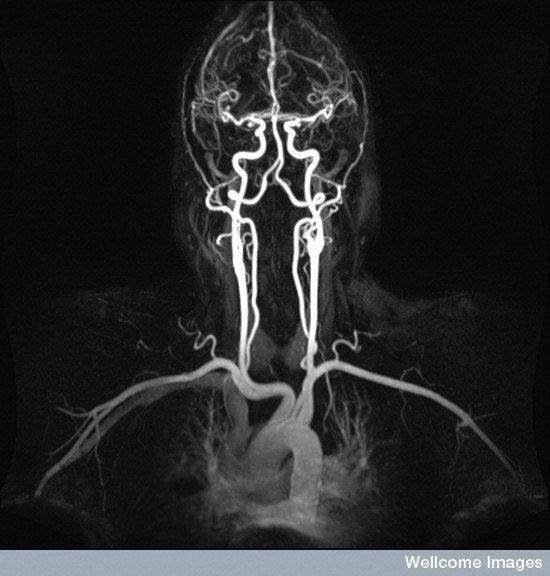When Snapchat sensation and Playboy model Katie May died unexpectedly this past February, the focus of attention moved from her plunging neckline to her neck.
Sadly, the 34-year-old suffered a lethal stroke a week after developing neck pain during a photo shoot, and a day after her third chiropractor visit for what she thought was (and may have been) a pinched nerve.
Initial tests showed that she had suffered a tear (“dissection”) in a vertebral artery. Any artery in the body can develop a dissection, but the arteries that course through the neck to feed the brain—an internal carotid on each side, and two vertebral arteries that course directly through the vertebrae of the neck—seem particularly susceptible.

The tear allows blood to forcibly pry (“dissect”) its way between the thin inner lining of the artery, and the thicker, muscular, outer portion of the artery. If the subsequent swelling is large enough to restrict blood flow, a stroke can occur as downstream brain cells die from lack of oxygen. More commonly, the injury attracts a blood clot, which breaks loose, and then floats downstream until it plugs up an artery.
Last week the LA County Coroner confirmed the initial clinical findings. The autopsy report ruled May’s death accidental and listed three causes: stroke, vertebral artery dissection, and “blunt force injury of neck.”
Although the words “chiropractic manipulation” don’t appear on the report, a flurry of press coverage questioned the causality, and a report in People quoted a spokesperson from the coroner’s office as saying the star died as a result of an injury sustained during a “neck manipulation by a chiropractor.”
And here’s where things get a little tricky. Arterial dissections typically involve either rotating the head, or moving the head backwards. They can occur in high-impact trauma, but in many cases, the possible precipitating event seems very minor. A New England Journal of Medicine review article lists potential inciting events as painting a ceiling, coughing, sneezing, vomiting, practicing yoga, finishing off a drink (a “bottoms-up dissection”), and getting your hair done (a “beauty-parlor stroke”).
It’s unclear why such relatively innocuous, fairly routine movements might suddenly have such serious consequences. May reportedly said her neck pain began after a photo shoot that required her to maintain an awkward pose. It’s possible that that’s what triggered her dissection, not the visit to the chiropractor.
Sometimes even the experts can’t be definitive. In 2014, the American Heart Association and the American Stroke Association released a consensus statement titled, “Neck Manipulation May Be Associated with Stroke.” Although studies show that neck manipulation is associated with an increased risk of arterial dissection, it’s hard to know how many of those folks went to the chiropractor looking for pain relief from symptoms that were—unbeknownst to them—from an arterial dissection.
What are the symptoms of an arterial dissection? That depends on which artery is affected and to what degree, but headache and neck or facial pain are the most common initial symptoms. Some people can hear a pulsatile ringing in their ears, or will notice that they have a droopy eyelid on the same side as the headache. Dissections of the vertebral artery, like Katie May’s, can be more subtle and seem like a muscle pull.
Stroke symptoms such as loss of vision or double vision, localized weakness, slurred speech, and dizziness typically develop several hours to days after the headache and pain. A pinched nerve or a slipped disc won’t give you those symptoms, so it’s off to the emergency room, not the chiropractor.
